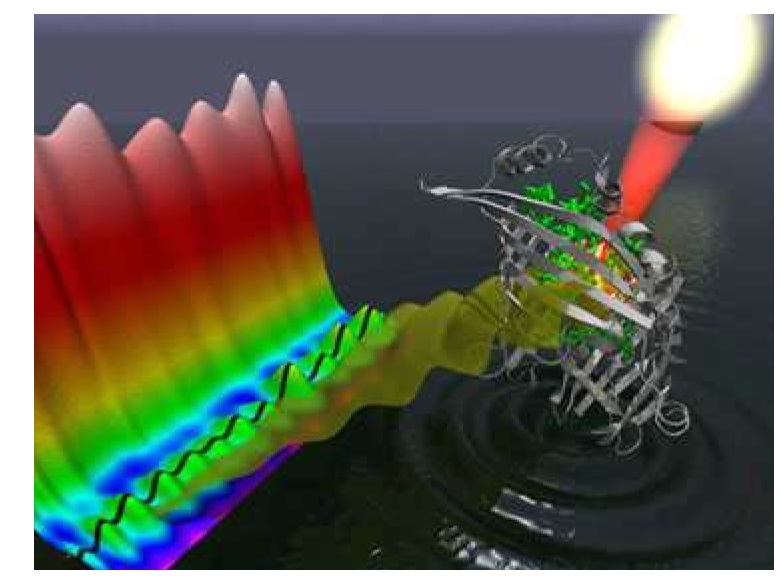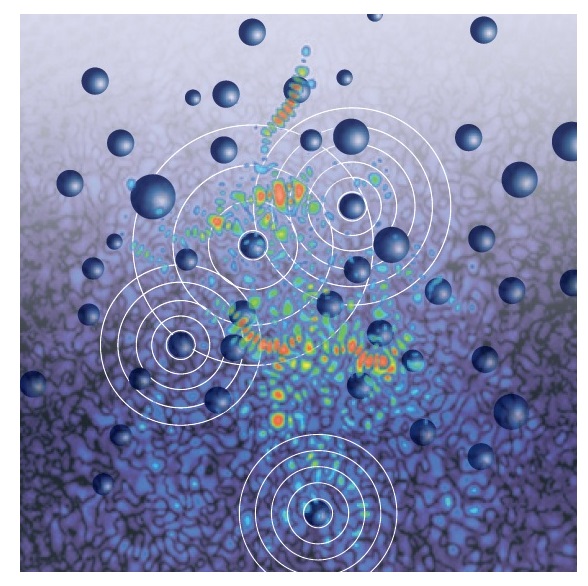Quantum Biology
Quantum Biology deals with quantum effects in photosynthetic systems. Evidence of a role of quantum coherence has been recently found in photosynthetic light-harvesting systems [1], and in other biological systems [2]. These findings raise many questions: how Nature can preserve quantum coherence in macromolecules in a wet and hot environment? what is the functional purpose of quantum coherence in Natural systems? All these questions are of paramount importance for building scalable quantum devices able to work at room temperature and their study is at the center of the newly born field of quantum biology.
[1] G. S. Engel et al., Nature, 446, 782 (2007)
[2] S. Lloyd, Nature, 474, 272 (2011)
PhD Research Projects:
 Transport and emergent properties in open quantum systems: application to photosynthetic complexes
Transport and emergent properties in open quantum systems: application to photosynthetic complexes
see more... Transport and emergent properties in open quantum systems: application to cold atoms
Transport and emergent properties in open quantum systems: application to cold atoms
see more...
Transport and emergent properties in open quantum systems: application to photosynthetic complexes
 Open quantum systems (i.e. systems that exchange matter and energy with an exter- nal environment) are at the center of many research areas: quantum computing, transport in mesoscopic systems, energy transfer in photosynthetic light-harvesting system and basic theoretical problems, such as the measurement problem in quantum mechanics. The PhD research projects we propose aim to investigate the interplay of openness and internal interaction in determining emergent properties in light harvesting photosynthetic sys- tems. Emergent properties arise from cooperative e_ects, therefore they belong to the system as a whole and not to its components. We experience the importance of emergent properties every day, examples of emergent properties is for instance life itself and consciousness. In particular in this line of research we intend to investigate energy transfer in photosyn- thetic light harvesting systems. The amount of energy humans use annually is delivered to Earth by the Sun in one hour! It could be of fundamental importance to use solar energy in an e_ective way. Most natural photosynthetic systems consist of antenna complexes, which capture photons from the Sun and transport energy to a reaction center. There, it is transformed into chemical energy via charge separation. Antenna complexes are able to transfer excitations to the reaction center with an e_ciency exceeding 95%. For a long time, it was thought that energy transfer in photosynthetic light-harvesting complexes occurs through a classical process, similar to a random walk of the exciton to the reaction center. Surprisingly, evidence of coherent quantum energy transfer has been recently found in photosynthetic light-harvesting systems at room temperature [1]. These _ndings raise two basic questions [2]: How can coherence be maintained in complex biological systems at room temperature? Why is quantum coherence relevant to the e_ciency of energy transfer?
Open quantum systems (i.e. systems that exchange matter and energy with an exter- nal environment) are at the center of many research areas: quantum computing, transport in mesoscopic systems, energy transfer in photosynthetic light-harvesting system and basic theoretical problems, such as the measurement problem in quantum mechanics. The PhD research projects we propose aim to investigate the interplay of openness and internal interaction in determining emergent properties in light harvesting photosynthetic sys- tems. Emergent properties arise from cooperative e_ects, therefore they belong to the system as a whole and not to its components. We experience the importance of emergent properties every day, examples of emergent properties is for instance life itself and consciousness. In particular in this line of research we intend to investigate energy transfer in photosyn- thetic light harvesting systems. The amount of energy humans use annually is delivered to Earth by the Sun in one hour! It could be of fundamental importance to use solar energy in an e_ective way. Most natural photosynthetic systems consist of antenna complexes, which capture photons from the Sun and transport energy to a reaction center. There, it is transformed into chemical energy via charge separation. Antenna complexes are able to transfer excitations to the reaction center with an e_ciency exceeding 95%. For a long time, it was thought that energy transfer in photosynthetic light-harvesting complexes occurs through a classical process, similar to a random walk of the exciton to the reaction center. Surprisingly, evidence of coherent quantum energy transfer has been recently found in photosynthetic light-harvesting systems at room temperature [1]. These _ndings raise two basic questions [2]: How can coherence be maintained in complex biological systems at room temperature? Why is quantum coherence relevant to the e_ciency of energy transfer?
[1] G. S. Engel et al., Nature, 446, 782 (2007)
[2] G. L. Celardo, F. Borgonovi, V. I. Tsifrinovich, M. Merkli and G. P. Berman, Journal of Physical Chemistry C, 116 (2012) 22105-22111
Figure: Solar light adsorbed by a clorophil molecule (green) in the FMO complex (grey), generates coherent oscillations of excitations. (Image courtesy of Greg Engel, Lawrence Berkeley National Laboratory, Physical Biosciences Division)
Transport and emergent properties in open quantum systems: application to cold atoms
 Open quantum systems (i.e. systems that exchange matter and energy with an external environment) are at the center of many research areas: quantum computing, transport in mesoscopic systems, energy transfer in photosynthetic light-harvesting system and basic theoretical problems, such as the measurement problem in quantum mechanics. The Ph.D. research projects we propose aim to investigate the interplay of openness and internal interaction in determining emergent properties in cold atoms systems. Emergent properties arise from cooperative e_ects, therefore they belong to the system as a whole and not to its components. We experience the importance of emergent properties every day, examples of emergent properties is for instance life itself and consciousness. In particular in this line of research we intend to investigate photon propagation in cold atoms systems. The interaction of cold atomic vapors with light is a very promising _eld of research. We plan to study the interplay of disorder and superradiance in these systems in collaboration with experimental groups (http://www.kaiserlux.de/coldatoms/). The main experimental goal is to achieve photon trapping in the cold atoms system by di_erent means, such as Anderson localization and Dicke subradiance [3]. On the theoretical side we plan to analyze both static disorder, which leads to Anderson localization, and time dependent disorder, which induces dephasing.
Open quantum systems (i.e. systems that exchange matter and energy with an external environment) are at the center of many research areas: quantum computing, transport in mesoscopic systems, energy transfer in photosynthetic light-harvesting system and basic theoretical problems, such as the measurement problem in quantum mechanics. The Ph.D. research projects we propose aim to investigate the interplay of openness and internal interaction in determining emergent properties in cold atoms systems. Emergent properties arise from cooperative e_ects, therefore they belong to the system as a whole and not to its components. We experience the importance of emergent properties every day, examples of emergent properties is for instance life itself and consciousness. In particular in this line of research we intend to investigate photon propagation in cold atoms systems. The interaction of cold atomic vapors with light is a very promising _eld of research. We plan to study the interplay of disorder and superradiance in these systems in collaboration with experimental groups (http://www.kaiserlux.de/coldatoms/). The main experimental goal is to achieve photon trapping in the cold atoms system by di_erent means, such as Anderson localization and Dicke subradiance [3]. On the theoretical side we plan to analyze both static disorder, which leads to Anderson localization, and time dependent disorder, which induces dephasing.
[3] G. L. Celardo, A. Biella, L. Kaplan, and F. Borgonovi, Fortschr. Phys., 1-11 (2012); DOI 10.1002; Special Issue on "Quantum Physics with Non-Hermitian Operators: Theory and Experiment"
Figure: Image taken from Ultracold matter: Disorderly arrest, R. Kaiser, Nature Physics, News and Views, 04 March 2012
